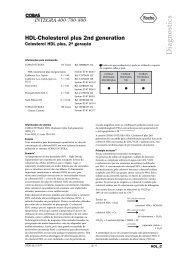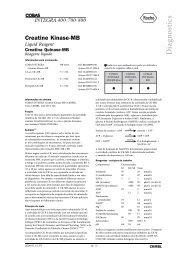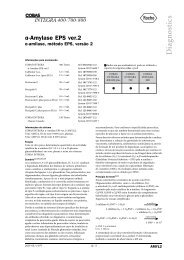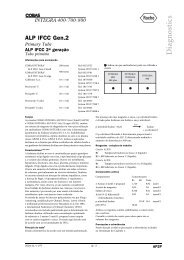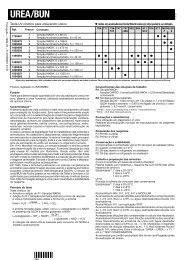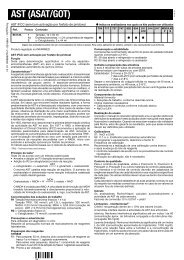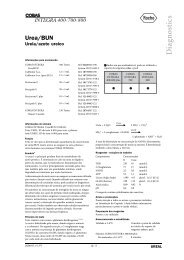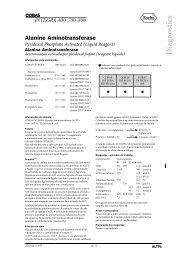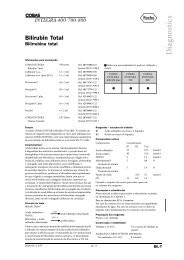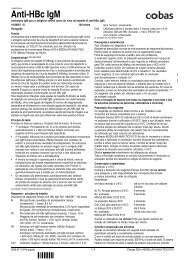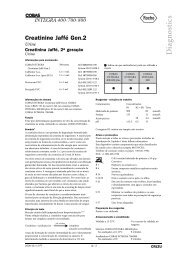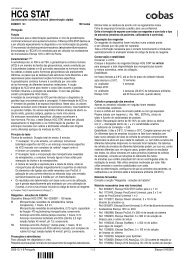LDL-C Plus
LDL-C Plus
LDL-C Plus
Create successful ePaper yourself
Turn your PDF publications into a flip-book with our unique Google optimized e-Paper software.
English – 1999-12 –<br />
2147068001 01 01<br />
<strong>LDL</strong>-C <strong>Plus</strong><br />
<strong>LDL</strong>-Cholesterol, no pretreatment Indicates Roche/Hitachi analyzer(s) on which kit(s) can be used<br />
Cat. no. Bottle Contents<br />
704 717 736<br />
737<br />
747 902 904 911<br />
912<br />
914 917 MODULAR<br />
P D<br />
1985604 1 \-Cyclodextrin/buffer, 6 x 14 ml<br />
2 Buffer/enzymes/4-aminoantipyrine, 3 x 10 ml<br />
1985612 1 \-Cyclodextrin/buffer, 6 x 36 ml<br />
2 Buffer/enzymes/4-aminoantipyrine, 3 x 25 ml<br />
1985639 1 \-Cyclodextrin/buffer, 6 x 54 ml<br />
2 Buffer/enzymes/4-aminoantipyrine, 6 x 20 ml<br />
1875892 1 \-Cyclodextrin/buffer, 6 x 267 ml<br />
1875914 2 Buffer/enzymes/4-aminoantipyrine, 6 x 103 ml<br />
1985647 1 \-Cyclodextrin/buffer, 5 x 252 ml<br />
1985655 2 Buffer/enzymes/4-aminoantipyrine, 3 x 110 ml<br />
Intended use<br />
Homogeneous enzymatic assay for the direct quantitative determination<br />
of <strong>LDL</strong>-cholesterol in human serum and plasma on automated<br />
clinical chemistry analyzers.<br />
Summary<br />
Low Density Lipoproteins (<strong>LDL</strong>) play a key role in causing and influencing<br />
the progression of atherosclerosis and coronary sclerosis in<br />
particular. The <strong>LDL</strong>s are derived from V<strong>LDL</strong>s (Very Low Density Lipoproteins)<br />
rich in triglycerides by the action of various lipolytic enzymes<br />
and are synthesized in the liver. The elimination of <strong>LDL</strong> from plasma<br />
takes place mainly by liver parenchymal cells via specific <strong>LDL</strong> receptors.<br />
Elevated <strong>LDL</strong> concentrations in blood and an increase in their residence<br />
time coupled with an increase in the biological modification rate<br />
results in the destruction of the endothelial function and a higher <strong>LDL</strong>cholesterol<br />
uptake in the monocyte/macrophage system as well as<br />
by smooth muscle cells in vessel walls. The majority of cholesterol<br />
stored in atherosclerotic plaques originates from <strong>LDL</strong>.<br />
The <strong>LDL</strong>-cholesterol value is the most powerful clinical predictor<br />
among all of the single parameters with respect to coronary atherosclerosis.<br />
Therefore, therapies focusing on lipid reduction primarily<br />
target the reduction of <strong>LDL</strong>-cholesterol which is then expressed in<br />
an improvement of the endothelial function, prevention of atherosclerosis<br />
and reducing its progression as well as preventing plaque<br />
rupture.<br />
Various methods are available for the determination of <strong>LDL</strong>-cholesterol<br />
such as ultracentrifugation as the reference method, lipoprotein<br />
electrophoresis and precipitation methods. In the precipitation<br />
methods apolipoprotein-B-containing <strong>LDL</strong>-cholesterol is, for example,<br />
precipitated using either polyvinyl sulfate, dextran sulfate or polycyclic<br />
anions. The <strong>LDL</strong>-cholesterol content is usually calculated from the<br />
difference between total cholesterol and cholesterol in the remainder<br />
(V<strong>LDL</strong>- and HDL-cholesterol) in the supernate after precipitation with<br />
polyvinyl sulfate and dextran sulfate. Lipid Research Clinics recommend<br />
a combination of ultracentrifugation and precipitation methods using<br />
polyanions in the presence of divalent cations. The precipitation<br />
methods are however time-consuming, cannot be automated and<br />
are susceptible to interference by hyperlipidemic serum, particularly<br />
at high concentrations of free fatty acids. A more recent method is<br />
based on the determination of <strong>LDL</strong>-cholesterol after the sample is<br />
subjected to immunoadsorption and centrifugation.<br />
The calculation of the <strong>LDL</strong>-cholesterol concentration according to<br />
Friedewald’s formula is commonly practised. The formula is based<br />
on 2 cholesterol determinations, 1 triglyceride determination as well<br />
as precipitation of the HDL particles and presumes that a direct<br />
relationship exists between V<strong>LDL</strong>-cholesterol and triglycerides in<br />
fasting blood samples. Even in the presence of small amounts of<br />
chylomicrons or abnormal lipoproteins, the formula gives rise to falsely<br />
low <strong>LDL</strong>-cholesterol values. For this reason a great need exists for a<br />
simple and reliable method for the determination of <strong>LDL</strong>-cholesterol<br />
without any preparatory steps or calculation.<br />
This automated method for the direct determination of <strong>LDL</strong>-cholesterol<br />
takes advantage of the selective micellary solubilization of<br />
<strong>LDL</strong>-cholesterol by a nonionic detergent and the interaction of a<br />
sugar compound and lipoproteins (V<strong>LDL</strong> and chylomicrons). When<br />
a detergent is included in the enzymatic method for cholesterol<br />
determination (cholesterol esterase cholesterol oxidase coupling<br />
reaction), the relative reactivities of cholesterol in the lipoprotein<br />
fractions increase in this order: HDL < chylomicrons < V<strong>LDL</strong> < <strong>LDL</strong>.<br />
In the presence of Mg ++ , a sugar compound markedly reduces the<br />
enzymatic reaction of the cholesterol measurement in V<strong>LDL</strong> and<br />
chylomicrons. The combination of a sugar compound with detergent<br />
enables the selective determination of <strong>LDL</strong>-cholesterol in serum. 1–8<br />
E 6549 – L1<br />
Some analyzers and kits shown may not be available in all countries. For additional system applications, contact your local Roche representative.<br />
Nonfasting sample results are slightly lower than fasting results.<br />
Comparable non-fasting results were observed with the beta<br />
quantification method. 9–11 This direct assay meets the 1995 NECP<br />
goals of < 4% Total CV, bias J 4% versus reference method, and<br />
J 12% total analytical error. 12<br />
Test principle<br />
Homogeneous enzymatic colorimetric assay<br />
• Sample and addition of R1<br />
V<strong>LDL</strong> Mg<br />
}<br />
++<br />
¼¼¼¼¼¼¼¼İ<br />
Chylomicrons Sugar compound<br />
• Addition of R2 and start of reaction:<br />
HDL<br />
V<strong>LDL</strong><br />
Chylomicrons } Detergent<br />
¼¼¼¼¼¼İ<br />
Detergent<br />
<strong>LDL</strong> + H 2 O ¼¼¼¼¼¼¼¼İ Cholesterol + free fatty acid<br />
Cholesterol esterase (selective micellary solubilization)<br />
Cholesterol oxidase<br />
Cholesterol + O 2 ¼¼¼¼¼¼¼¼İ Cholestenone + H 2O 2<br />
Peroxidase<br />
2H 2 O 2 + 4AA* + HSDA** + H 2 O + H + ¼¼¼¼İ Purple blue<br />
pigment + 5H 2O<br />
(Abs.max = 585 nm)<br />
Working solution concentration<br />
R1 \-Cyclodextrin/buffer<br />
MOPS (3-morpholinopropane sulfonic acid buffer): 50 mmol/l, pH<br />
7.0; \-cyclodextrin sulfate: 0.1 g/l; dextran sulfate: 0.7 g/l;<br />
Mg 2 SO 4 ·7H 2 O: 7 g/l; HSDA**: 0.3 g/l; AOD (Eupenicillium spec.,<br />
recombinant): 3 U/l; peroxidase (horseradish): 10 U/l; preservative<br />
R2 Buffer/enzymes/4-aminoantipyrine<br />
MOPS: 50 mmol/l, pH 7.0; 4-aminoantipyrine: 0.51 g/l; cholesterol<br />
esterase (Pseudomonas spec.) > 0.7 U/l; cholesterol oxidase<br />
(Pseudomonas spec.) D 0.3 U/l; peroxidase (horseradish)<br />
D 20 U/l; detergent; preservative<br />
* AA = 4-aminoantipyrine<br />
** HSDA = Sodium N–(2–hydroxy–3–sulfopropyl)–3,5–dimethoxyaniline<br />
AOD = ascorbate oxidase<br />
Precautions and warnings<br />
For in vitro diagnostic use.<br />
Exercise the normal precautions required for handling all laboratory<br />
reagents.<br />
Reagent handling<br />
R1: Ready for use<br />
R2: Ready for use<br />
Selective<br />
inhibition<br />
Selective<br />
micellary formation<br />
Storage and stability<br />
Unopened kit components: Up to the expiration date at 2–8°C<br />
R1: 28 days opened and refrigerated on the analyzer<br />
R2: 28 days opened and refrigerated on the analyzer<br />
0<br />
6<br />
2
<strong>LDL</strong>-C <strong>Plus</strong><br />
Specimen collection and preparation<br />
Collect serum using standard sampling tubes.<br />
Li- or Na-heparin plasma.<br />
Stability 11 : 7 days at 2–8°C<br />
30 days at -70°C<br />
Fasting and non-fasting samples can be used. 10 EDTA plasma causes<br />
decreased values.<br />
Centrifuge samples containing precipitate before performing the assay.<br />
Testing procedure<br />
Materials provided<br />
• Working solutions as described above<br />
Additional materials required<br />
• Calibrators and controls as indicated below<br />
• 0.9% NaCl<br />
Assay<br />
Refer to the appropriate operator’s manual and/or the Instrument<br />
Settings section of this insert for analyzer-specific assay instructions.<br />
The performance of applications not validated by Roche is not warranted<br />
and must be defined by the user.<br />
Calibration<br />
Standardization: The method is traceable to the beta quantification<br />
method as defined in the recommendations in the <strong>LDL</strong> Cholesterol<br />
Method Certification Protocol for Manufacturers. 12<br />
S1: 0.9% NaCl<br />
S2: C.f.a.s. (Calibrator for automated systems) HDL/<strong>LDL</strong>-C plus<br />
Calibration frequency<br />
Two point calibration is recommended<br />
• after reagent lot change<br />
• as required following quality control procedures<br />
Calibration verification: Not necessary.<br />
Quality control<br />
For quality control, use Precinorm L, Precipath HDL/<strong>LDL</strong>-C, or other<br />
suitable control material.<br />
The control intervals and limits must be adapted to the individual<br />
laboratory and country-specific requirements. Values obtained<br />
should fall within established limits. Each laboratory should establish<br />
corrective measures to be taken if values fall outside the limits.<br />
Calculation<br />
Roche/Hitachi systems automatically calculate the <strong>LDL</strong>-cholesterol<br />
concentration of each sample.<br />
Conversion factor: mg/dl x 0.0259 = mmol/l<br />
mmol/l x 38.66 = mg/dl<br />
Limitations – interference 11<br />
(US users refer to application sheet for special wash instructions.)<br />
To avoid probe and cuvette carry-over to Tina-quant U Albumin,<br />
Lp(a), Lipase, and Magnesium, use the Evasion software with SMS/<br />
Acid Wash, Multiclean, or NaOH D in the <strong>LDL</strong>-cholesterol assay.<br />
Criterion: Recovery within ± 10% of initial values.<br />
Icterus: No significant interference up to an I index of 60 (approximate<br />
conjugated and unconjugated bilirubin concentration: 60 mg/dl).<br />
Hemolysis: No significant interference up to an H index of 1000<br />
(approximate hemoglobin concentration: 1000 mg/dl).<br />
Lipemia (Intralipid): No significant interference up to an L index of<br />
200. Dilute samples with L index > 200 with 0.9% NaCl (e.g. 1 + 3).<br />
No significant interference from native triglycerides up to 1200 mg/dl.<br />
Dilute samples with triglycerides > 1200 with 0.9% NaCl (e.g. 1 + 3).<br />
Multiply the result by the appropriate dilution factor (e.g. 4).<br />
Rheumatoid factors < 200 IU/ml do not interfere. Ascorbic acid up<br />
to 50 mg/dl and oleic acid up to 4.0 mmol/l do not interfere.<br />
No significant interference from HDL, V<strong>LDL</strong>, or chylomicrons.<br />
In rare cases, elevated immunoglobulin concentrations can lead to<br />
falsely elevated <strong>LDL</strong>-cholesterol results.<br />
Abnormal liver function does affect lipid metabolism; consequently<br />
HDL and <strong>LDL</strong> results are of limited diagnostic value. In some patients<br />
with abnormal liver function, the <strong>LDL</strong>-C plus result is significantly<br />
negatively biased versus beta quantification results.<br />
Measuring/reportable range<br />
3–550 mg/dl (0.03–5.5 g/l or 0.077–14.2 mmol/l)<br />
Determine samples with <strong>LDL</strong>-cholesterol concentrations > 550 mg/dl<br />
via the rerun function. On instruments without rerun function, manually<br />
dilute samples with 0.9% NaCl (e.g. 1 + 1). Multiply the result by the<br />
appropriate dilution factor (e.g. 2).<br />
2147068001 02 01<br />
Expected values8,13 Levels in terms of risk for coronary heart disease:<br />
Adult levels:<br />
Recommended (desirable) < 130 mg/dl (
English – 1999-12 – 2147068001 03 01<br />
<strong>LDL</strong>-C <strong>Plus</strong><br />
References<br />
1 Rifai N, Warnick GR, McNamara JR, Belcher JD, Grinstead GF,<br />
Frantz Jr ID. Measurement of Low-Density-Lipoprotein Cholesterol<br />
in Serum: a Status Report. Clin Chem 1992;38:150–160.<br />
2 Cremer P, Seidel D. Lipoproteinanalytik: Methodische Empfehlungen.<br />
DG Klinische Chemie. Mitteilungen 1990;21:215–232.<br />
3 National Cholesterol Education Program. Expert Panel on Detection,<br />
Evaluation, and Treatment of High Blood Cholesterol in Adults<br />
(Adult Treatment Panel II). NIH Publication No. 93–3095, 1995.<br />
4 Naito HK, Strong JP, Scott MG, Roheim PS, Asztalos BF, Zilversmit<br />
DB, Srinivasan SR, Berenson GS, Wilson PWF, Scanu AM, Malikow<br />
MR. Atherogenesis: current topics on etiology and risk factors. Clin<br />
Chem 1995;41:132–133 No. 1.<br />
5 Wieland H, Seidel D. Quantitative Lipoprotein Electrophoresis.<br />
In: Handbook of Electrophoresis, Vol III, ed. Lewis A., Boca Raton:<br />
CRC Press, 83–102, 1983.<br />
6 Armstrong V, Seidel D. Evaluation of a Commercial Kit for the<br />
Determination of <strong>LDL</strong>-Cholesterol in Serum Based on Precipitation<br />
of <strong>LDL</strong> with Dextran Sulfate. Ärztl. Lab. 1985;31:325–330.<br />
7 Friedewald WF, Levy RI, Frederickson DS. Estimation of <strong>LDL</strong>-<br />
Cholesterol Concentration without Use of the Preparative Ultracentrifuge.<br />
Clin Chem 1972;18:499–502.<br />
8 Bachorik PS, Ross JW. National cholesterol education program<br />
recommendations for measurement of low-density lipoprotein<br />
cholesterol: executive summary. Clin Chem 1995;41:1414–1420.<br />
9 Cohn JS, McNamara JR, Schaefer EJ. Lipoprotein Cholesterol<br />
Concentrations in the Plasma of Human Subjects as Measured<br />
in the Fed and Fasted States. Clin Chem 1988;34:2456–2459.<br />
10 Pisani T, Gebski CP, Leary ET, et al. Accurate Direct Determination<br />
of Low-Density Lipopotein Cholesterol Using an Immuno-separation<br />
Reagent and Enzymatic Cholesterol Assay. Arch Pathol Lab Med<br />
1995;119:1127.<br />
11 Data on file at Roche.<br />
12 <strong>LDL</strong> Cholesterol Method Certification Protocol for Manufacturers.<br />
National Reference System for Cholesterol. Cholesterol Reference<br />
Method Laboratory Network. October 1997.<br />
13 Tietz, NW. Clinical Guide to Laboratory Tests. 3rd ed. WB Saunders<br />
Co, Philadelphia, Pa. 1995:404–407.<br />
14 Cremer P, Nagel D, Mann H et al. Ten-year follow-up results from<br />
the Goettingen Risk, Incidence and Prevalence Study (GRIPS). I.<br />
Risk factors for myocardial infarction in a cohort of 5790 men.<br />
Atherosclerosis 1997;129:221–230.<br />
15 Passing H, Bablok W. A New Biometrical Procedure for Testing the<br />
Equality of Measurements from Two Different Analytical Methods.<br />
J Clin Chem Clin Biochem 1983;21:709–720.<br />
16 Bablok W et al. A General Regression Procedure for Method<br />
Transformation. J Clin Chem Clin Biochem 1988;26:783–790.<br />
Instrument settings<br />
US users<br />
Refer to application sheet for additional operating information.<br />
Roche/Hitachi 736 and 914 customers<br />
Refer to application sheet for parameters.<br />
Roche/Hitachi 904, 911, 912, 917 and MODULAR users<br />
Read in the application parameters from the application diskette or<br />
barcode sheet, as appropriate.<br />
Roche/Hitachi 704<br />
Temperature: 37°C<br />
PROGRAM 2 CHEMISTRY PARAMETERS<br />
TEST [<strong>LDL</strong>]<br />
ASSAY CODE [1(1 POINT)] – [31] – [0]<br />
SAMPLE VOLUME [4]<br />
R1 VOLUME [300] – [50] – [NO]<br />
R2 VOLUME [100] – [20] – [NO]<br />
WAVELENGTH [700] – [600]<br />
CALIB. METHOD [LINEAR] – [0] – [0]<br />
STD. (1) CONC.-POS.<br />
STD. (2) CONC.-POS.<br />
STD. (3) CONC.-POS.<br />
[<br />
----<br />
] – [<br />
----<br />
]<br />
[<br />
----<br />
] – [<br />
----<br />
]<br />
[0] – [0]<br />
STD. (4) CONC.-POS. [0] – [0]<br />
STD. (5) CONC.-POS. [0] – [0]<br />
STD. (6) CONC.-POS. [0] – [0]<br />
UNIT<br />
SD LIMIT<br />
[<br />
----<br />
]<br />
[0.1]<br />
DUPLICATE LIMIT [100]<br />
SENSITIVITY LIMIT [700]<br />
ABS. LIMIT (INC/DEC) [0] – [INCREASE]<br />
PROZONE LIMIT [32000] – [UPPER]<br />
EXPECTED VALUE<br />
INSTRUMENT FACTOR<br />
---- Data entered by the operator<br />
[<br />
----<br />
] – [<br />
----<br />
]<br />
[1.00]<br />
Roche/Hitachi 717<br />
Temperature: 37°C<br />
PROGRAM 2 CHEMISTRY PARAMETERS<br />
TEST [<strong>LDL</strong>]<br />
ASSAY CODE [1(1 POINT)] – [50] – [0]<br />
SAMPLE VOLUME [4] – [3]<br />
R1 VOLUME [300] – [50] – [NO]<br />
R2 VOLUME [100] – [20] – [NO]<br />
WAVELENGTH [700] – [600]<br />
CALIB. METHOD [LINEAR] – [0] – [0]<br />
STD. (1) CONC.-POS.<br />
STD. (2) CONC.-POS.<br />
STD. (3) CONC.-POS.<br />
[<br />
----<br />
] – [<br />
----<br />
]<br />
[<br />
----<br />
] – [<br />
----<br />
]<br />
[0] – [0]<br />
STD. (4) CONC.-POS. [0] – [0]<br />
STD. (5) CONC.-POS. [0] – [0]<br />
STD. (6) CONC.-POS. [0] – [0]<br />
SD LIMIT [999]<br />
DUPLICATE LIMIT [100]<br />
SENSITIVITY LIMIT [700]<br />
ABS. LIMIT (INC/DEC) [0] – [INCREASE]<br />
PROZONE LIMIT [32000] – [UPPER]<br />
EXPECTED VALUE<br />
PANIC VALUE<br />
INSTRUMENT FACTOR<br />
---- Data entered by the operator<br />
[<br />
----<br />
] – [<br />
----<br />
]<br />
[<br />
----<br />
] – [<br />
----<br />
]<br />
[1.00]
<strong>LDL</strong>-C <strong>Plus</strong><br />
Roche/Hitachi 737<br />
Temperature: 37°C<br />
SYSTEM PARAMETERS CHAPTER 9.0. ..... (CHEMISTRY)<br />
TEST NAME <strong>LDL</strong><br />
1. ASSAY CODE END – 20 – 00<br />
2. SAMPLE VOLUME (µl) 4<br />
3. R 1 VOLUME (µl) 300 ......<br />
4. R 2 VOLUME (µl) 100<br />
5. WAVELENGTH 1 600 nm<br />
WAVELENGTH 2 700 nm<br />
6. COMPENSATE LIMIT 0.0<br />
7. CALIBRATION<br />
REQ. NO CALIB. ID CONC<br />
1) 01 D SALINE 0<br />
2) 02<br />
3)<br />
4)<br />
5)<br />
6)<br />
7)<br />
CALIB. Assigned value<br />
8. EQUATION NO (1–5) 1<br />
9. FACTOR (FIXED) .....<br />
10. UNIT FACTOR 1.00<br />
11. ABS. LIMIT (RATE) 0<br />
INC/DEC INC<br />
---- Data entered by the operator<br />
Roche/Hitachi 747<br />
Temperature: 37°C<br />
PROGRAM 4.2 CHEMISTRY PARAMETERS<br />
TEST ...... (<strong>LDL</strong>)<br />
ASSAY CODE 1 – 50 – 00<br />
WAVELENGTH 700 (SUB) – 600 (MAIN)<br />
SERUM URINE<br />
SAMPLE VOLUME (µl) 4 – 3 [ ] – [ ]<br />
EXPECTED VALUE 0.0 – 00.0 [ ] – [ ]<br />
PANIC VALUE ...... – ...... [ ] – [ ]<br />
ABS. LIMIT (INC/DEC) 0 – INC [ ] – [ ]<br />
PROZONE LIMIT 32000 – UPPER [ ] – [ ]<br />
R1 R2<br />
R1/R2 VOLUME (µl) 300 100<br />
R1/R2 DUMMY INTERVAL 0 0<br />
DILUTION VOLUME (µl) 0<br />
CALIB. METHOD LINEAR<br />
POINTS 2<br />
STD 1 CONC RACK POS (NaCl) 0.0 – ......... – 0<br />
STD 2 CONC RACK POS Value – ......... – ....<br />
STD 3 CONC RACK POS 0 – 0 – 0<br />
STD 4 CONC RACK POS 0 – 0 – 0<br />
STD 5 CONC RACK POS 0 – 0 – 0<br />
STD 6 CONC RACK POS 0 – 0 – 0<br />
SD LIMIT 999<br />
DUPLICATE LIMIT 100<br />
SENSITIVITY LIMIT 700<br />
STD 1 ABS. LEVEL [-100]– [500].....<br />
INSTRUMENT FACTOR 1.00<br />
..... Data entered by the operator<br />
2147068001 04 01<br />
Roche/Hitachi 902<br />
No. <br />
1 Test Name <strong>LDL</strong><br />
2 Assay Code (Mthd) 1 Point<br />
3 Assay Code (2. Test) 0<br />
4 Reaction Time 10<br />
5 Assay Point 1 35<br />
6 Assay Point 2 0<br />
7 Assay Point 3 0<br />
8 Assay Point 4 0<br />
9 Wavelength (SUB) 700<br />
10 Wavelength (MAIN) 600<br />
11 Sample Volume 4.0<br />
12 R1 Volume 300<br />
13 R1 Position .....<br />
14 R1 Bottle Size Large<br />
15 R2 Volume 0<br />
16 R2 Position 0<br />
17 R2 Bottle Size Large<br />
18 R3 Volume 100<br />
19 R3 Position .....<br />
20 R3 Bottle Size Small<br />
21 Calib. Type (Type) Linear<br />
22 Calib. Type (Wght) 2<br />
23 Calib. Conc. 1 0<br />
24 Calib. Pos. 1 .....<br />
25 Calib. Conc. 2 .....<br />
26 Calib. Pos. 2 .....<br />
27 Calib. Conc. 3 0<br />
28 Calib. Pos. 3 0<br />
29 Calib. Conc. 4 0<br />
30 Calib. Pos. 4 0<br />
31 Calib. Conc. 5 0<br />
32 Calib. Pos. 5 0<br />
33 Calib. Conc. 6 0<br />
34 Calib. Pos. 6 0<br />
35 S1 ABS. 0<br />
36 K Factor 00000<br />
37 K2 Factor 10000<br />
38 K3 Factor 10000<br />
39 K4 Factor 10000<br />
40 K5 Factor 10000<br />
41 A Factor 0<br />
42 B Factor 0<br />
43 C Factor 0<br />
44 SD Limit 0.1<br />
45 Duplicate Limit 100<br />
46 Sens. Limit 700<br />
47 S1ABS. Limit (L) -100<br />
48 S1ABS. Limit (H) 500<br />
49 ABS. Limit 0<br />
50 ABS. Limit (D/I) Increase<br />
51 Prozone Limit 32000<br />
52 Proz Limit (Upp/Low) Upper<br />
53 Prozone (End Point) 00<br />
54 Expect. Value (L) ......<br />
55 Expect. Value (H) .......<br />
56 Instr. Fact. (a) 1.0<br />
57 Instr. Fact. (b) 0.0<br />
58 Key Setting .....<br />
.... Data entered by the operator<br />
For detailed information, consult the operator manuals for Roche/Hitachi systems,<br />
the respective application sheets and the package inserts for the calibrators and<br />
control sera.<br />
Tina-quant, Precinorm and Precipath are trademarks of a member of the Roche Group.<br />
Intralipid is a trademark of KabiPharmacia, Inc.<br />
©1999 Roche Diagnostics<br />
Roche Diagnostics GmbH, D-68298 Mannheim, Germany<br />
Roche Diagnostics Corporation, Indianapolis, IN, USA<br />
US Customer Technical Support 1-800-428-2336<br />
December 1999
Português– 1999-12 – 2147068001 05 01<br />
<strong>LDL</strong>-C <strong>Plus</strong><br />
Colesterol <strong>LDL</strong>, sem tratamento prévio Indica o(s) analisador(es) Roche/Hitachi no(s) qual(ais) o(s) kit(s) pode(m) ser utilizados<br />
Ref. Frasco Conteúdo Produto registado no INFARMED<br />
704 717 736 747<br />
737<br />
902 904 911 914 917 MODULAR<br />
912 P D<br />
1985604 1 \-ciclodextrina/tampão, 6 x 14 ml<br />
2 Tampão/enzimas/4-aminoantipirina, 3 x 10 ml<br />
1985612 1 \-ciclodextrina/tampão, 6 x 36 ml<br />
2 Tampão/enzimas/4-aminoantipirina, 3 x 25 ml<br />
1985639 1 \-ciclodextrina/tampão, 6 x 54 ml<br />
2 Tampão/enzimas/4-aminoantipirina, 6 x 20 ml<br />
1875892 1 \-ciclodextrina/tampão, 6 x 267 ml<br />
1875914 2 Tampão/enzimas/4-aminoantipirina, 6 x 103 ml<br />
1985647 1 \-ciclodextrina/tampão, 5 x 252 ml<br />
1985655 2 Tampão/enzimas/4-aminoantipirina, 3 x 110 ml<br />
Alguns dos analisadores podem não ser comercializados em todos os países. Para outras aplicações do sistema, contacte o seu representante local da Roche.<br />
Função<br />
Teste enzimático homogéneo para determinação quantitativa directa<br />
do colesterol-<strong>LDL</strong> em soro e plasma humanos, utilizando analisadores<br />
automáticos de química clínica.<br />
Características<br />
As lipoproteínas de baixa densidade (<strong>LDL</strong>- Low Density Lipoproteins)<br />
desempenham um papel fulcral na formação e desenvolvimento da<br />
aterosclerose e, especialmente, da esclerose coronária. As <strong>LDL</strong> derivam<br />
das lipoproteínas de muito baixa densidade (V<strong>LDL</strong> - Very Low<br />
Density Lipoproteins) ricas em triglicéridos através da acção de vários<br />
enzimas lipolíticos, sendo sintetizadas no fígado. A eliminação das<br />
<strong>LDL</strong> do plasma ocorre sobretudo através das células do parênquima<br />
hepático, por meio de receptores específicos das <strong>LDL</strong>. Concentrações<br />
ele-vadas de <strong>LDL</strong> no sangue e um aumento do tempo de permanência<br />
associado a um aumento da taxa de modificação biológica resulta<br />
na destruição da função endotelial e numa captação superior do<br />
colesterol-<strong>LDL</strong> pelo sistema monócitos/macrófagos e pelas células<br />
dos músculos lisos nas paredes dos vasos sanguíneos. A maior parte<br />
do colesterol armazenado nas placas ateroscleróticas deriva das <strong>LDL</strong>.<br />
O valor do colesterol-<strong>LDL</strong> é o mais potente factor de previsão clínico<br />
de todos os parâmetros, no que diz respeito à aterosclerose coronária.<br />
Por conseguinte, as terapêuticas que visam a redução lipídica têm<br />
como principal alvo a redução do colesterol-<strong>LDL</strong> que resulta num<br />
melhoramento da função endotelial e na prevenção da aterosclerose,<br />
reduzindo a sua progressão e evitando a ruptura das placas.<br />
São vários os métodos existentes para determinação do colesterol<br />
<strong>LDL</strong>, como a ultracentrifugação como método de referência, a electroforese<br />
de lipoproteínas e os métodos de precipitação. Nestes últimos,<br />
o colesterol-<strong>LDL</strong> que contém apolipoproteína B é, por ex., precipitado,<br />
utilizando sulfato de polivinilo, sulfato de dextrano ou aniões policíclicos.<br />
Normalmente, o colesterol-<strong>LDL</strong> é calculado a partir da diferença<br />
entre o colesterol total e o colesterol no sobrenadante (colesterol V<strong>LDL</strong><br />
e HDL) após precipitação com sulfato de polivinilo e sulfato de dextrano.<br />
Os centros de investigação sobre lípidos recomendam uma combinação<br />
dos métodos de ultracentrifugação e precipitação, utilizando<br />
polianiões na presença de catiões divalentes. Contudo, os métodos<br />
de precipitação são demorados, não podem ser automatizados e<br />
estão sujeitos a interferências pelos soros hiperlipidémicos, sobretudo<br />
com concentrações elevadas de ácidos gordos livres. Um método<br />
mais re-cente baseia-se na determinação do colesterol-<strong>LDL</strong> depois<br />
de a amostra ser sujeita a imunoadsorção e centrifugação.<br />
Habitualmente, o cálculo da concentração de colesterol-<strong>LDL</strong> é feito<br />
de acordo com a fórmula de Friedewald. Esta baseia-se em 2 determinações<br />
de colesterol, 1 determinação de triglicéridos e precipitação<br />
das partículas de HDL. Presume-se que existe uma relação directa<br />
entre o colesterol-V<strong>LDL</strong> e os triglicéridos nas amostras sanguíneas<br />
de indivíduos em jejum. Mesmo na presença de pequenas quantidades<br />
de quilomicrões ou lipoproteínas anómalas, a fórmula origina valores<br />
falsamente baixos do colesterol-<strong>LDL</strong>. Por este motivo, é absolutamente<br />
necessário criar um método simples e fiável para determinação do<br />
colesterol-<strong>LDL</strong> sem quaisquer fases de preparação ou cálculo.<br />
Este método automático de determinação directa do colesterol <strong>LDL</strong><br />
utiliza a solubilização micelar selectiva do colesterol-<strong>LDL</strong> por um detergente<br />
não-iónico e a interacção de um composto de açúcar e das lipoproteínas<br />
(V<strong>LDL</strong> e quilomicrões). Quando se inclui um detergente no<br />
método enzimático de determinação do colesterol (reacção de acoplamento<br />
da colesterol esterase - colesterol oxidase), as actividades relativas<br />
do colesterol nas fracções de lipoproteínas aumentam pela seguinte<br />
ordem: HDL < quilomicrões < V<strong>LDL</strong> < <strong>LDL</strong>. Na presença de<br />
Mg ++ , um composto de açúcar diminui claramente a reacção<br />
enzimática da medição de colesterol em V<strong>LDL</strong> e quilomicrões. A<br />
combinação de um composto de açúcar com um detergente permite<br />
a determinação selectiva do colesterol-<strong>LDL</strong> no soro. 1–8<br />
1162<br />
Os resultados obtidos em amostras de indivíduos que não estavam<br />
em jejum são ligeiramente mais baixos do que os obtidos com indivíduos<br />
em jejum. Com o método de beta-quantificação, obtiveram-se<br />
resultados comparáveis. 9–11 Este ensaio directo respeita os objectivos<br />
de 1995 do NECP de < 4% CV Total, desvio J 4% versus método de<br />
referência, e J 12% de erro analítico total. 12<br />
Princípio do teste<br />
Ensaio colorimétrico enzimático homogéneo<br />
• Amostra e adição do R1<br />
V<strong>LDL</strong> Mg ++<br />
} ¼¼¼¼¼¼¼İ Inibição selectiva<br />
Quilomicrões Composto de açúcar<br />
• Adição do R2 e início da reacção:<br />
HDL<br />
V<strong>LDL</strong> } Detergente Formação<br />
Quilomicrões ¼¼¼¼¼¼¼İ micelar<br />
selectiva<br />
Detergente<br />
<strong>LDL</strong> + H 2 O ¼¼¼¼¼¼¼¼İ Colesterol + ácido gordo livre<br />
Colesterol esterase (solubilização micelar<br />
selectiva)<br />
Colesterol oxidase<br />
Colesterol + O 2 ¼¼¼¼¼¼¼¼İ Colestenona + H 2 O 2<br />
Peroxidase<br />
2H2O2 + 4AA* + HSDA** + H2O + H + ¼¼¼¼İ Pigmento<br />
violeta + 5H2O (abs.max = 585 nm)<br />
Concentrações das soluções de trabalho<br />
R1 \-ciclodextrina/tampão<br />
MOPS (tampão ácido de 3-morfolinopropano sulfónico): 50 mmol/l,<br />
pH 7,0; sulfato de \-ciclodextrina: 0,1 g/l; sulfato de dextrano:<br />
0,7 g/l; Mg2SO4 · 7H 2O: 7 g/l; HSDA**: 0,3 g/l; AOD (Eupenicillium<br />
spec, recombinante): 3 U/l; peroxidase (rábano): 10 U/l; conservante<br />
R2 Tampão/enzimas/4-aminoantipirina<br />
MOPS: 50 mmol/l, pH 7,0; 4-aminoantipirina: 0,51 g/l; colesterol<br />
esterase (espec. de pseudomonas) > 0,7 U/l; colesterol oxidase<br />
(espec. de pseudomonas) D 0,3 U/l; peroxidase (rábano)<br />
D 20 U/l; detergente; conservante<br />
* AA = 4-aminoantipirina<br />
** HSDA = Sódio N–(2–hidroxi–3–sulfopropilo)–3,5–dimetoxianilina<br />
AOD = ascorbato oxidase<br />
Precauções e advertências<br />
Para utilização em diagnóstico in vitro.<br />
Respeite as precauções normais de manuseamento de reagentes<br />
laboratoriais.<br />
Preparação dos reagentes<br />
R1: Pronto a ser utilizado.<br />
R2: Pronto a ser utilizado.<br />
Conservação e estabilidade<br />
Componentes no kit fechado: até ao fim do prazo de validade indicado<br />
quando conservado a 2–8°C<br />
R1: 28 dias aberto e refrigerado no analisador<br />
R2: 28 dias aberto e refrigerado no analisador<br />
0<br />
6<br />
2
<strong>LDL</strong>-C <strong>Plus</strong><br />
Colheita e preparação das amostras<br />
O soro é recolhido em tubos de amostra standard.<br />
Plasma Li- ou Na-.<br />
Estabilidade11 : 7 dias a 2–8°C<br />
30 dias a -70°C<br />
Utilize amostras de indivíduos que estavam em jejum e que não estavam<br />
em jejum. 10 O plasma tratado com EDTA causa uma redução dos<br />
valores. As amostras que contêm precipitado têm de ser centrifugadas<br />
antes da realização do ensaio.<br />
Componentes do teste<br />
Material fornecido<br />
• Soluções de trabalho, conforme descritas acima.<br />
Outros materiais necessários<br />
• Calibradores e controlos conforme indicado abaixo.<br />
• NaCI a 0,9%<br />
Realização do ensaio<br />
Consulte o manual do operador apropriado e/ou a secção relativa às<br />
definições do analisador nesta bula para obter instruções mais específicas<br />
sobre o analisador.<br />
Quando se executam ensaios não validados pela Roche, esta não<br />
garante os resultados, pelo que esses ensaios devem ser definidos<br />
pelo utilizador.<br />
Calibração<br />
Padronização: Trata-se de um método vestigial do método de beta<br />
quantificação, conforme definido nas recomendações do Protocolo<br />
de Certificação do Método do Colesterol-<strong>LDL</strong> para Fabricantes. 12<br />
S 1: NaCI a 0,9%<br />
S 2: C.f.a.s. (Calibrador para sistemas automáticos) HDL/<strong>LDL</strong>-C plus<br />
Frequência da calibração<br />
Recomenda-se a realização de uma calibração de dois pontos:<br />
• após mudança do lote de reagentes<br />
• conforme necessário de acordo com os procedimentos de controlo<br />
necessários<br />
Verificação da calibração: não é necessária.<br />
Controlo de qualidade<br />
Para o controlo de qualidade, utilize o Precinorm L, Precipath HDL/<br />
<strong>LDL</strong>-C ou outros materiais de controlo adequados.<br />
Os intervalos e os limites de controlo deverão ser adaptados às exigências<br />
específicas de cada laboratório e aos requisitos específicos<br />
de cada país. Os valores obtidos devem situar-se dentro dos intervalos<br />
definidos. Cada laboratório deverá estabelecer as suas próprias normas<br />
no que diz respeito às medidas correctivas a tomar no caso de<br />
os valores se situarem fora do intervalo definido.<br />
Cálculo<br />
Os sistemas Roche/Hitachi calculam automaticamente a concentração<br />
de colesterol-<strong>LDL</strong> de cada amostra.<br />
Factor de conversão: mg/dl x 0,0259 = mmol/l<br />
mmol/l x 38,66 = mg/dl<br />
Limitações – interferências11 (Utilizadores norte-americanos: consultar a folha de aplicação para<br />
informações sobre as instruções especiais de lavagem).<br />
Para evitar o arrastamento das pipetas e cuvetes utilizadas para as<br />
determinações Tina-quant U Albumina, Lp (a), Lipase e Magnésio,<br />
utilize o software Evasion com SMS/Acid Wash, Multiclean ou NAOH<br />
D na determinação do colesterol-<strong>LDL</strong>.<br />
Critério: recuperação dentro de ± 10% dos valores iniciais.<br />
Icterícia: Nenhuma interferência significativa até um índice I de 60<br />
(conc. aprox. de bilirrubina conjugada e não-conjugada: 60 mg/dl).<br />
Hemólise: Nenhuma interferência significativa até um índice H de<br />
1000 (conc. aprox. de hemoglobina: 1000 mg/dl).<br />
Lipemia (dispersão de luz): Nenhuma interferência significativa até um<br />
índice L de 200. As amostras com um índice L > 200 são diluídas com<br />
NaCI a 0,9% (p. ex. 1 + 3). Nenhuma interferência significativa dos<br />
triglicéridos nativos até 1200 mg/dl. As amostras com triglicéridos<br />
> 1200 são diluídas com NaCI a 0,9% (p. ex. 1 + 3). Multiplique o<br />
resultado pelo factor de diluição adequado (p. ex. 4).<br />
Os factores reumatóides < 200 UI/ml, o ácido ascórbico até 50 mg/<br />
dl e o ácido oléico até 4,0 mmol/l não interferem com o teste.<br />
Nenhuma interferência significativa de HDL, V<strong>LDL</strong> ou quilomicrões.<br />
Em casos raros, concentrações elevadas de imunoglobulina podem<br />
conduzir a resultados falsamente elevados de colesterol-<strong>LDL</strong>.<br />
A função hepática anómala não afecta o metabolismo lipídico; consequentemente,<br />
os resultados de HDL e <strong>LDL</strong> têm um valor limitado em<br />
termos de diagnóstico. Em alguns doentes com função hepática<br />
anómala, o resultado do <strong>LDL</strong>-C plus pode ter um desvio negativo<br />
significativo relativamente aos resultados da beta-quantificação.<br />
2147068001 06 01<br />
1162<br />
Intervalo de medição/referência<br />
3–550 mg/dl (0,03–5,5 g/l ou 0,077–14,2 mmol/l)<br />
Determine as amostras com concentrações de colesterol-<strong>LDL</strong> > 550<br />
mg/dl através da função de reanálise. Nos analisadores sem função<br />
de reanálise, dilua manualmente as amostras com a solução de NaCI<br />
a 0,9% (p. ex. 1 + 1). Multiplique o resultado pelo factor de diluição<br />
adequado (p. ex. 2).<br />
Valores teóricos 8,13<br />
Níveis em termos de risco para cardiopatia coronária:<br />
Em adultos:<br />
Recomendados (desejáveis) < 130 mg/dl (< 3,37 mmol/l)<br />
Risco moderado: J 130–159 mg/dl (3,37–4,12 mmol/l)<br />
Risco elevado: D160 mg/dl (D 4,14 mmol/l)<br />
Valores recomendados segundo o estudo GRIPS 14<br />
mg/dl mmol/l<br />
145 3,8 Para doentes com cardiopatia coronária comprovada<br />
170 4,4 Para doentes com um ou mais factores de<br />
risco<br />
200 5,2 Para doentes sem factores de risco e sem<br />
cardiopatia coronária comprovada<br />
Cada laboratório deve verificar se os valores teóricos podem ser<br />
aplicados à sua própria população de doentes e, se necessário,<br />
determinar os seus próprios valores de referência. Quando o objectivo<br />
é o diagnóstico, os resultados do colesterol-<strong>LDL</strong> devem ser sempre<br />
interpretados em conjunto com a anamnese do doente, o exame<br />
clínico e outros resultados.<br />
Dados específicos sobre o desempenho do teste<br />
São apresentados a seguir dados representativos do desempenho<br />
utilizando um analisador Roche/Hitachi. Os resultados podem diferir<br />
de laboratório para laboratório.<br />
Imprecisão11 A reprodutibilidade foi determinada com soros humanos e controlos<br />
num protocolo interno (n = 21). Obtiveram-se os seguintes resultados:<br />
Intra-série Entre dias<br />
Amostra Média SD %CV Média SD %CV<br />
mg/dl mg/dl mg/dl mg/dl<br />
Soro humano 108,2 0,83 0,8 108,4 2,93 2,7<br />
Precinorm L 94,8 0,75 0,8 94,8 2,60 2,7<br />
Precipath HDL/<strong>LDL</strong> 211,1 2,19 1,0 210,3 3,93 1,9<br />
SD = desvio-padrão (Standard Deviation)<br />
CV = coeficiente de variação<br />
Sensibilidade analítica (limite de detecção inferior) 11<br />
Limite de detecção: 3 mg/dl (0,03 g/l ou 0,078 mmol/l)<br />
O limite de detecção inferior representa a concentração mais baixa<br />
de colesterol-<strong>LDL</strong> passível de ser distinguida de zero. É calculado como<br />
a concentração situada 3 desvios-padrão acima do padrão mais<br />
baixo (padrão zero + 3SD, precisão intra-ensaio, n = 21).<br />
Comparação dos métodos 11<br />
A. Uma comparação da determinação do colesterol-<strong>LDL</strong>, utilizando<br />
o ensaio colesterol-<strong>LDL</strong> plus da Roche (y) com outra determinação<br />
do colesterol-<strong>LDL</strong> (x), utilizando um método directo semelhante<br />
num analisador Roche/Hitachi 911, teve como resultado as seguintes<br />
correlações (mg/dl):<br />
Passing Bablok 15,16 Regressão linear<br />
y = -12,46 + 1,041 x y = -13,50 +1,051 x<br />
r = 0,978 r = 0,980<br />
SD (md 95) = 12,76 Sy.x = 6,62<br />
Número de amostras medidas: 138<br />
As concentrações variaram entre 32,5 e 284,4 mg/dl.<br />
B. Uma comparação da determinação do colesterol-<strong>LDL</strong>, utilizando<br />
o ensaio colesterol-<strong>LDL</strong> plus da Roche num analisador Roche/<br />
Hitachi 911 (y) com a determinação do colesterol-<strong>LDL</strong> pelo método<br />
de beta-quantificação (ultracentrifugação e precipitação com<br />
ácido fosfotungstico/cloreto de magnésio), teve como resultado<br />
as seguintes correlações (mg/dl):<br />
Passing Bablok 15,16 Regressão linear<br />
y = -5,597 + 1,018 x y = -2,590 + 1,002 x<br />
r = 0,985 r = 0,985<br />
SD (md 95) = 9,13 Sy.x = 3,95<br />
Número de amostras medidas: 40<br />
As concentrações variaram entre 69 e 208 mg/dl.
Português – 1999-12 – 2147068001 07 01<br />
<strong>LDL</strong>-C <strong>Plus</strong><br />
C. Uma comparação num analisador Roche/Hitachi 911 da determinação<br />
do colesterol-<strong>LDL</strong>, utilizando o ensaio colesterol-<strong>LDL</strong> plus da Roche<br />
(y) com a determinação do colesterol-<strong>LDL</strong> PVS (x), teve como resultado<br />
as seguintes correlações (mg/dl):<br />
Passing Bablok 15,16 Regressão linear<br />
y = 1,77 +0,97 x y = 5,86 + 0,94 x<br />
r = 0,983 r = 0,983<br />
SD (md 95) = 8,56 Sy.x = 4,50<br />
Número de amostras medidas: 49<br />
As concentrações das amostras variaram entre 58,6 e 216,3 mg/<br />
dl.<br />
Bibliografia<br />
1 Rifai N, Warnick GR, McNamara JR, Belcher JD, Grinstead GF,<br />
Frantz Jr ID. Measurement of Low-Density-Lipoprotein Cholesterol<br />
in Serum: a Status Report. Clin Chem 1992;38:150–160.<br />
2 Cremer P, Seidel D. Lipoproteinanalytik: Methodische Empfehlungen.<br />
DG Klinische Chemie. Mitteilungen 1990;21:215–232.<br />
3 National Cholesterol Education Program. Expert Panel on Detection,<br />
Evaluation, and Treatment of High Blood Cholesterol in Adults<br />
(Adult Treatment Panel II). NIH Publication No. 93–3095, 1995.<br />
4 Naito HK, Strong JP, Scott MG, Roheim PS, Asztalos BF, Zilversmit<br />
DB, Srinivasan SR, Berenson GS, Wilson PWF, Scanu AM, Malikow<br />
MR. Atherogenesis: current topics on etiology and risk factors.<br />
Clin Chem 1995;41:132–133 No. 1.<br />
5 Wieland H, Seidel D. Quantitative Lipoprotein Electrophoresis.<br />
In: Handbook of Electrophoresis, Vol III, ed. Lewis A., Boca Raton:<br />
CRC Press, 83–102, 1983.<br />
6 Armstrong V, Seidel D. Evaluation of a Commercial Kit for the<br />
Determination of <strong>LDL</strong>-Cholesterol in Serum Based on Precipitation<br />
of <strong>LDL</strong> with Dextran Sulfate. Ärztl. Lab. 1985;31:325–330.<br />
7 Friedewald WF, Levy RI, Frederickson DS. Estimation of <strong>LDL</strong>-<br />
Cholesterol Concentration without Use of the Preparative Ultracentrifuge.<br />
Clin Chem 1972;18:499–502.<br />
8 Bachorik PS, Ross JW. National cholesterol education program<br />
recommendations for measurement of low-density lipoprotein<br />
cholesterol: executive summary. Clin Chem 1995;41:1414–1420.<br />
9 Cohn JS, McNamara JR, Schaefer EJ. Lipoprotein Cholesterol<br />
Concentrations in the Plasma of Human Subjects as Measured<br />
in the Fed and Fasted States. Clin Chem 1988;34:2456–2459.<br />
10 Pisani T, Gebski CP, Leary ET, y cols. Accurate Direct Determination<br />
of Low-Density Lipopotein Cholesterol Using an Immuno-separation<br />
Reagent and Enzymatic Cholesterol Assay. Arch Pathol Lab Med<br />
1995;119:1127.<br />
11 Documentação da Roche.<br />
12 <strong>LDL</strong> Cholesterol Method Certification Protocol for Manufacturers.<br />
National Reference System for Cholesterol. Cholesterol Reference<br />
Method Laboratory Network. October 1997.<br />
13 Tietz, NW. Clinical Guide to Laboratory Tests. 3 a ed. WB Saunders<br />
Co, Philadelphia, Pa. 1995:404–407.<br />
14 Cremer P, Nagel D, Mann H et al. Ten-year follow-up results from<br />
the Goettingen Risk, Incidence and Prevalence Study (GRIPS). I.<br />
Risk factors for myocardial infarction in a cohort of 5790 men.<br />
Atherosclerosis 1997;129:221–230.<br />
15 Passing H, Bablok W. A New Biometrical Procedure for Testing<br />
the Equality of Measurements from Two Different Analytical Methods.<br />
J Clin Chem Clin Biochem 1983;21:709–720.<br />
16 Bablok W et al. A General Regression Procedure for Method<br />
Transformation. J Clin Chem Clin Biochem 1988;26:783–790.<br />
1163<br />
Definições do analisador<br />
Utilizadores norte-americanos<br />
Para mais informações sobre o funcionamento, consulte a folha da<br />
aplicação.<br />
Clientes do Roche/Hitachi 736 e 914<br />
Para mais informações sobre os parâmetros, consulte a folha da<br />
aplicação.<br />
Utilizadores do Roche/Hitachi 904, 911, 912, 917 e MODULAR<br />
Introduza os parâmetros da aplicação a partir da disquete ou da folha<br />
com o código de barras, conforme adequado.<br />
Roche/Hitachi 704<br />
Temperatura: 37°C<br />
PROGRAM 2 CHEMISTRY PARAMETERS<br />
TEST [<strong>LDL</strong>]<br />
ASSAY CODE [1(1 POINT)] – [31] – [0]<br />
SAMPLE VOLUME [4]<br />
R1 VOLUME [300] – [50] – [NO]<br />
R2 VOLUME [100] – [20] – [NO]<br />
WAVELENGTH [700] – [600]<br />
CALIB. METHOD [LINEAR] – [0] – [0]<br />
STD. (1) CONC.-POS.<br />
STD. (2) CONC.-POS.<br />
STD. (3) CONC.-POS.<br />
[<br />
----<br />
] – [<br />
----<br />
]<br />
[<br />
----<br />
] – [<br />
----<br />
]<br />
[0] – [0]<br />
STD. (4) CONC.-POS. [0] – [0]<br />
STD. (5) CONC.-POS. [0] – [0]<br />
STD. (6) CONC.-POS. [0] – [0]<br />
UNIT<br />
SD LIMIT<br />
[<br />
----<br />
]<br />
[0.1]<br />
DUPLICATE LIMIT [100]<br />
SENSITIVITY LIMIT [700]<br />
ABS. LIMIT (INC/DEC) [0] – [INCREASE]<br />
PROZONE LIMIT [32000] – [UPPER]<br />
EXPECTED VALUE<br />
INSTRUMENT FACTOR<br />
[<br />
----<br />
] – [<br />
----<br />
]<br />
[1.00]<br />
----<br />
Dados introduzidos pelo operador<br />
Roche/Hitachi 717<br />
Temperatura: 37°C<br />
PROGRAM 2 CHEMISTRY PARAMETERS<br />
TEST [<strong>LDL</strong>]<br />
ASSAY CODE [1(1 POINT)] – [50] – [0]<br />
SAMPLE VOLUME [4] – [3]<br />
R1 VOLUME [300] – [50] – [NO]<br />
R2 VOLUME [100] – [20] – [NO]<br />
WAVELENGTH [700] – [600]<br />
CALIB. METHOD [LINEAR] – [0] – [0]<br />
STD. (1) CONC.-POS.<br />
STD. (2) CONC.-POS.<br />
STD. (3) CONC.-POS.<br />
[<br />
----<br />
] – [<br />
----<br />
]<br />
[<br />
----<br />
] – [<br />
----<br />
]<br />
[0] – [0]<br />
STD. (4) CONC.-POS. [0] – [0]<br />
STD. (5) CONC.-POS. [0] – [0]<br />
STD. (6) CONC.-POS. [0] – [0]<br />
SD LIMIT [999]<br />
DUPLICATE LIMIT [100]<br />
SENSITIVITY LIMIT [700]<br />
ABS. LIMIT (INC/DEC) [0] – [INCREASE]<br />
PROZONE LIMIT [32000] – [UPPER]<br />
EXPECTED VALUE<br />
PANIC VALUE<br />
INSTRUMENT FACTOR<br />
[<br />
----<br />
] – [<br />
----<br />
]<br />
[<br />
----<br />
] – [<br />
----<br />
]<br />
[1.00]<br />
---- Dados introduzidos pelo operador
<strong>LDL</strong>-C <strong>Plus</strong><br />
Roche/Hitachi 737<br />
Temperatura: 37°C<br />
SYSTEM PARAMETERS CHAPTER 9.0. ..... (CHEMISTRY)<br />
TEST NAME <strong>LDL</strong><br />
1. ASSAY CODE END – 20 – 00<br />
2. SAMPLE VOLUME (µl) 4<br />
3. R 1 VOLUME (µl) 300 ......<br />
4. R 2 VOLUME (µl) 100<br />
5. WAVELENGTH 1 600 nm<br />
WAVELENGTH 2 700 nm<br />
6. COMPENSATE LIMIT 0.0<br />
7. CALIBRATION<br />
REQ. NO CALIB. ID CONC<br />
1) 01 D SALINE 0<br />
2) 02<br />
3)<br />
4)<br />
5)<br />
6)<br />
7)<br />
CALIB. Assigned value<br />
8. EQUATION NO (1–5) 1<br />
9. FACTOR (FIXED) .....<br />
10. UNIT FACTOR 1.00<br />
11. ABS. LIMIT (RATE) 0<br />
INC/DEC INC<br />
---- Dados introduzidos pelo operador<br />
Roche/Hitachi 747<br />
Temperatura: 37°C<br />
PROGRAM 4.2 CHEMISTRY PARAMETERS<br />
TEST ...... (<strong>LDL</strong>)<br />
ASSAY CODE 1 – 50 – 00<br />
WAVELENGTH 700 (SUB) – 600 (MAIN)<br />
SERUM URINE<br />
SAMPLE VOLUME (µl) 4 – 3 [ ] – [ ]<br />
EXPECTED VALUE 0.0 – 00.0 [ ] – [ ]<br />
PANIC VALUE ...... – ...... [ ] – [ ]<br />
ABS. LIMIT (INC/DEC) 0 – INC [ ] – [ ]<br />
PROZONE LIMIT 32000 – UPPER [ ] – [ ]<br />
R1 R2<br />
R1/R2 VOLUME (µl) 300 100<br />
R1/R2 DUMMY INTERVAL 0 0<br />
DILUTION VOLUME (µl) 0<br />
CALIB. METHOD LINEAR<br />
POINTS 2<br />
STD 1 CONC RACK POS (NaCl) 0.0 – ......... – 0<br />
STD 2 CONC RACK POS Value – ......... – ....<br />
STD 3 CONC RACK POS 0 – 0 – 0<br />
STD 4 CONC RACK POS 0 – 0 – 0<br />
STD 5 CONC RACK POS 0 – 0 – 0<br />
STD 6 CONC RACK POS 0 – 0 – 0<br />
SD LIMIT 999<br />
DUPLICATE LIMIT 100<br />
SENSITIVITY LIMIT 700<br />
STD 1 ABS. LEVEL [-100]– [500].....<br />
INSTRUMENT FACTOR 1.00<br />
---- Dados introduzidos pelo operador<br />
2147068001 08 01<br />
1163<br />
Roche/Hitachi 902<br />
No. <br />
1 Test Name <strong>LDL</strong><br />
2 Assay Code (Mthd) 1 Point<br />
3 Assay Code (2. Test) 0<br />
4 Reaction Time 10<br />
5 Assay Point 1 35<br />
6 Assay Point 2 0<br />
7 Assay Point 3 0<br />
8 Assay Point 4 0<br />
9 Wavelength (SUB) 700<br />
10 Wavelength (MAIN) 600<br />
11 Sample Volume 4.0<br />
12 R1 Volume 300<br />
13 R1 Position .....<br />
14 R1 Bottle Size Large<br />
15 R2 Volume 0<br />
16 R2 Position 0<br />
17 R2 Bottle Size Large<br />
18 R3 Volume 100<br />
19 R3 Position .....<br />
20 R3 Bottle Size Small<br />
21 Calib. Type (Type) Linear<br />
22 Calib. Type (Wght) 2<br />
23 Calib. Conc. 1 0<br />
24 Calib. Pos. 1 .....<br />
25 Calib. Conc. 2 .....<br />
26 Calib. Pos. 2 .....<br />
27 Calib. Conc. 3 0<br />
28 Calib. Pos. 3 0<br />
29 Calib. Conc. 4 0<br />
30 Calib. Pos. 4 0<br />
31 Calib. Conc. 5 0<br />
32 Calib. Pos. 5 0<br />
33 Calib. Conc. 6 0<br />
34 Calib. Pos. 6 0<br />
35 S1 ABS. 0<br />
36 K Factor 00000<br />
37 K2 Factor 10000<br />
38 K3 Factor 10000<br />
39 K4 Factor 10000<br />
40 K5 Factor 10000<br />
41 A Factor 0<br />
42 B Factor 0<br />
43 C Factor 0<br />
44 SD Limit 0.1<br />
45 Duplicate Limit 100<br />
46 Sens. Limit 700<br />
47 S1ABS. Limit (L) -100<br />
48 S1ABS. Limit (H) 500<br />
49 ABS. Limit 0<br />
50 ABS. Limit (D/I) Increase<br />
51 Prozone Limit 32000<br />
52 Proz Limit (Upp/Low) Upper<br />
53 Prozone (End Point) 00<br />
54 Expect. Value (L) ......<br />
55 Expect. Value (H) .......<br />
56 Instr. Fact. (a) 1.0<br />
57 Instr. Fact. (b) 0.0<br />
58 Key Setting .....<br />
.... Dados introduzidos pelo operador<br />
Para mais informações, consulte o manual do operador dos sistemas Roche/Hitachi,<br />
as folhas da aplicação respectiva e as bulas dos calibradores e dos soros de controlo.<br />
Fabricado por:<br />
Roche Diagnostics GmbH, D-68298 Mannheim, Alemanha<br />
Distribuidor em Portugal:<br />
Roche Farmacêutica Química, Lda, 2700 Amadora<br />
Dezembro 1999



